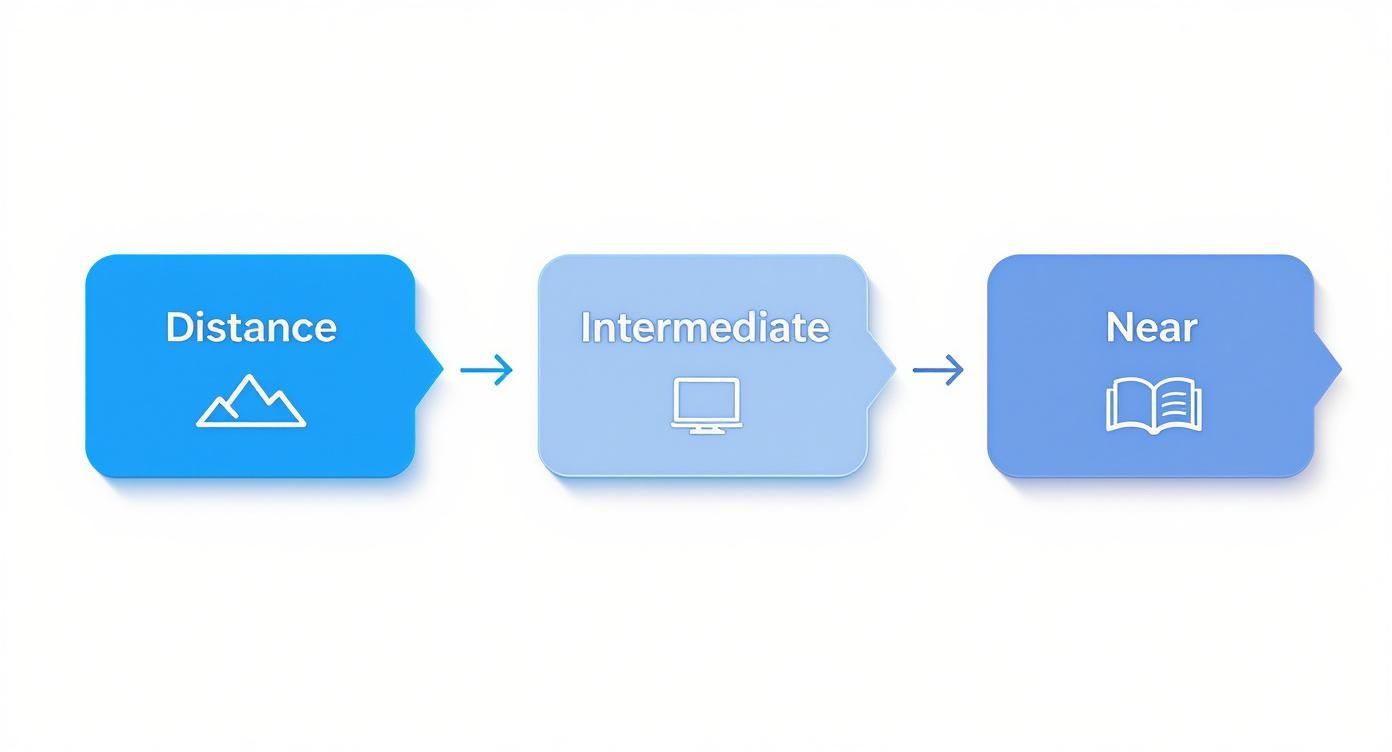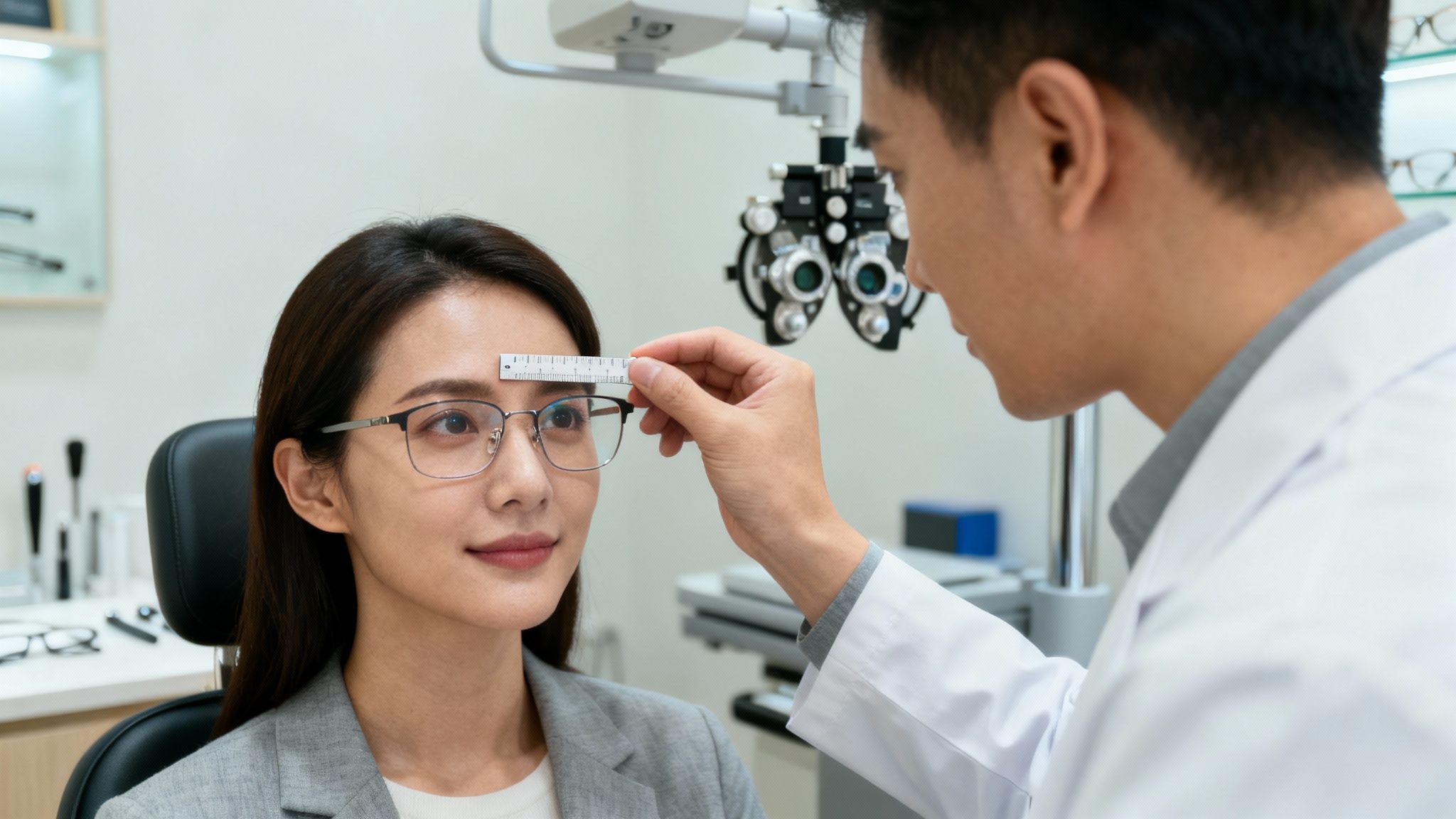Getting the hang of new progressive lenses is all about teaching your brain and eyes to work together in a new way. For first-timers here in Glendale Heights, the real secret is simple: point your nose directly at what you want to see, then simply tilt your chin up or down to find the sharpest focus. It sounds easy, and with a little practice, it will be.
Your First Look Through Progressive Lenses
Welcome to the world of seamless vision! If you've just picked up your first pair of progressive lenses from iDoctor, you're on your way to seeing clearly at any distance without those distracting lines you find on old-school bifocals.
Think of your new glasses as having three vision "zones" that blend into one another. The top part is for distance—perfect for spotting road signs on North Avenue or watching the kids play at Camera Park. The middle handles your intermediate vision, like looking at your computer or the car's dashboard. The bottom is dedicated to close-up tasks, like reading a menu or a text message.
This handy infographic shows you how it all flows together.
As you can see, it's a natural movement—looking straight ahead for things far away and lowering your eyes for anything up close.
The Science of Seamless Vision
Unlike bifocals with that hard, visible line, progressives feature a gradual shift in prescription power. This is a huge deal because it gets rid of the dizzying "image jump" that can make simple things like walking down stairs feel tricky. If you're curious about the nitty-gritty differences, we break it all down in our guide on progressive lenses vs. bifocals.
This sophisticated lens design is a big reason why progressives are so popular. The global eyewear market, which includes all kinds of spectacle lenses, was valued at a massive USD 155.4 billion in 2024 and is still climbing. Progressives are a key part of that growth, offering a modern solution that fits how we actually use our eyes today.
The core idea behind progressives is powerful yet simple: the lenses are engineered to follow your natural eye movements. By blending different prescription strengths into a single lens, they deliver a far more intuitive and comfortable experience than older multifocal designs.
Mastering them just takes one small but important change in your habits. Instead of darting your eyes side-to-side, you’ll quickly learn to turn your head to keep whatever you're looking at in the sweet spot of the lens. This little adjustment is the key to unlocking crisp, effortless vision at every single distance.
Navigating Daily Life With Your New Lenses
Now that you’ve mapped out each vision zone, it’s time to weave that knowledge into familiar routines. Muscle memory is your best ally for making progressives feel instinctive. You’ll soon switch between near, intermediate, and distance without a second thought.
Everyday tasks can highlight the strengths of these lenses—or expose small challenges. Think of each situation as a mini workshop where you fine-tune your setup. This approach makes adaptation faster and more intuitive.
Mastering Your Desk Setup
Few things strain your neck and eyes faster than a misaligned monitor. A quick tweak to screen height can eliminate even the most stubborn headaches.
Aim to anchor your gaze in the intermediate zone—the sweet spot for computer work. Here’s how to set up your workstation:
- Monitor Height: Position the top of the screen at or just below eye level to encourage a gentle downward glance.
- Chair Position: Keep your feet flat on the floor and your back fully supported to prevent slumping.
- Standing Desk Riser: If you alternate between sitting and standing, adjust the riser so the screen stays at a consistent eye-to-screen distance.
A brief posture reminder every half hour can work wonders. A small sticky note on your monitor can nudge you back into alignment.
Pro Tip: Catching yourself craning your neck means it’s time for another height adjustment.
Reading Books, Phones, And Menus
When you shift focus to reading, the lower segment of your lenses takes center stage. Instead of tilting your head, simply drop your eyes.
Hold your phone or a cookbook about 14–16 inches from your face. That distance is the sweet spot where text snaps into view without arm fatigue.
- Book Position: Rest the book or tablet on your lap or a pillow to maintain that ideal distance.
- Lighting Tip: Soft, indirect lighting reduces glare and helps letters stand out.
- Phone Tilt: Slightly angle the screen away to cut down on reflections.
Cushioned armrests can also support your elbows during longer reads. It eases shoulder tension and keeps your posture steady.
Handling Tricky Situations Like Stairs
Stepping down a curb or descending stairs can feel awkward because you’re peering through the reading zone. A subtle chin tuck reroutes your gaze through the distance-vision area, bringing the ground into sharp focus.
- Neighborhood Stroll: Practice this motion while walking along Main Street in Glendale Heights.
- Grocery Run Drill: Tuck your chin each time you shop at Jewel-Osco on Bloomingdale Road, especially when stepping down an aisle.
- Transit Tip: Use it when you step off a bus or train platform for extra clarity.
Once you feel comfortable, try it on different surfaces—grassy slopes or gravel paths. You’ll find your balance and confidence improving fast.
Mastering these simple drills builds confidence in no time. If any blur persists, swing by for designer eyeglasses in Glendale Heights for a quick fine-tune at iDoctor.
The Adaptation Period: What to Really Expect
Let's be honest: adjusting to progressive lenses is a journey, not an overnight switch. Your brain and eyes are learning an entirely new way of seeing, so giving yourself some grace during this process is key.
Most people start to feel comfortable within a few days, but it's not unusual for full adaptation to take up to two weeks. If things don't feel perfectly sharp on day one, don't panic. That’s completely normal. Knowing what’s coming helps you navigate the transition with a lot more confidence and a lot less frustration.
Common Sensations You Might Experience
For the first few days, you'll likely notice some odd visual effects. Think of it as your brain recalibrating to the new lens technology. These sensations are temporary and almost always fade as you wear the glasses more.
- A Mild "Swim" Effect: This is the big one. When you turn your head quickly, the world in your peripheral vision might seem to wobble or swim a bit. It's the most common sensation new wearers report.
- Slight Depth Perception Issues: You might find yourself misjudging the height of a curb or the last step on a staircase. Just be a little more cautious when you're walking around at first.
- Initial Eye Strain: Your eye muscles are working in a new way to find the different zones in the lens, so they might feel a bit tired. This is temporary and gets better with consistent use.
If we could give you one piece of advice, it would be this: wear your new glasses full-time. It’s so tempting to switch back to your old pair for a little relief, but that just confuses your brain and drags out the adaptation process. The fastest way to make your new progressives feel like a part of you is to stick with them.
To learn more about this crucial phase, check out our guide on how long it generally takes to get used to new glasses.
Remember: The goal is to make the lenses adapt to your life, not the other way around. By consistently wearing them, you are teaching your brain to automatically find the right focus for every task without conscious thought.
Why Adaptation Is Worth It
Think of it like learning to use a new, powerful tool. Successfully adapting to progressives is a bit like a user onboarding process—you're getting familiar with a new system. In fact, understanding the principles behind user onboarding best practices can help you set the right expectations for yourself.
And people are definitely catching on. The global market for progressive lenses was valued at around USD 11.5 billion in 2023 and is projected to hit USD 19.3 billion by 2032. That kind of growth is a testament to how many people are successfully getting that clear, line-free vision they've been wanting.
A professional fitting is absolutely non-negotiable. More often than not, when someone struggles to adapt, the problem isn't the lens—it's the fit. If your frames are constantly sliding down your nose or sitting too high, the vision zones will never line up where they're supposed to. That's why our team at iDoctor in Glendale Heights is so meticulous with our measurements during our detailed eye exams in Glendale Heights. We make sure your frames are positioned perfectly from the start.
Troubleshooting Common Lens Challenges
Even with a perfect fitting, hitting a few small snags is a normal part of the process. Think of it as the final fine-tuning stage. Most issues are minor and disappear with a few small tweaks to your habits or a quick stop at our boutique for an adjustment.
Don't get discouraged if things feel a bit strange at first. The most common hurdle new wearers face is blurry peripheral (side) vision. This isn't a defect in your lenses; it's just how they're designed.
The fix is surprisingly simple: get used to turning your head and pointing your nose directly at whatever you want to see clearly, instead of just shifting your eyes. This one small change makes a world of difference.
Another classic frustration, especially during our chilly Glendale Heights winters, is when your glasses fog up. It's already tricky finding your focus zone without having to deal with a foggy view. We have some great, practical solutions in our guide on how to stop your glasses from fogging up in winter.
A Quick Mental Checklist
If you’re dealing with headaches or eye strain that sticks around for more than a week, it’s usually a sign that something is slightly off. Before you start to worry, run through this quick mental checklist. Often, a simple habit change is all it takes.
- Nose Direction: Are you pointing your nose at what you want to see? This is the golden rule for sharp vision with progressives.
- Chin Position: Are you tilting your chin correctly for the task? A slight lift for distance, a slight drop for reading.
- Frame Placement: Are your glasses sitting high on the bridge of your nose where they belong? If they've slid down, the carefully measured vision zones won't line up with your eyes.
Sometimes, just being mindful of these small things is the solution. For example, if you're trying to read a menu at a restaurant on Army Trail Road and the text is fuzzy, double-check that your chin is down and you're looking through the bottom part of your lenses.
If you've consistently applied these tips for a few days and your vision still doesn't feel right, don't just "live with it." A simple, precise frame adjustment from a professional is often all that’s needed to make things perfect.
Solving Common Progressive Lens Issues
To make things even clearer, we've put together this quick-reference table. It covers the most frequent challenges new wearers run into, what they feel like, and what to do about them.
| The Problem | What It Feels Like | What to Try First | When to Call Your Optometrist |
|---|---|---|---|
| Blurry Side Vision | A "swimmy" or distorted feeling when looking out the sides of your lenses. | Turn your head to face objects directly instead of just moving your eyes. Point your nose where you want to look. | If the feeling is severe or doesn't improve after a week of practice. |
| Headaches or Eye Strain | A persistent, dull ache behind the eyes or in the temples, especially after a few hours of wear. | Check your posture. Ensure your glasses haven't slid down your nose and that you're using the right chin tilt. | If headaches continue for more than 3-4 days despite self-correction. |
| Trouble Reading | You have to hold things at an odd angle or the text is only clear in a very small spot. | Lower your chin slightly and bring your reading material up to meet your gaze through the bottom part of the lens. | If you can't find a comfortable reading position after a few days. |
| Dizziness or Imbalance | A "rocking boat" sensation, especially when walking, climbing stairs, or moving your head quickly. | Take it slow. Make smaller, more deliberate head movements. Practice looking through the top of the lenses when walking. | If dizziness is significant or doesn't subside within the first week. |
This table should help you pinpoint exactly what's going on and give you a clear path forward.
When these self-checks don't solve the problem, it's time to let us help. The issue could be a tiny misalignment that our opticians can correct in a matter of minutes. Your comfort is our top priority.
If you’re still feeling off after trying these troubleshooting steps, please don’t hesitate to visit the best optometrist in Glendale Heights. A quick follow-up adjustment at iDoctor can make all the difference in achieving the crystal-clear, comfortable vision you deserve.
Protecting Your Eyewear Investment
Your new progressive lenses are a big deal, especially when they’re sitting in a beautiful pair of Cartier, Tom Ford, or Gucci frames from our curated collection. Think of them as a high-performance tool for your vision. And just like any precision instrument, a little care goes a long way in keeping them looking and working great for years.
A few simple daily habits are all it takes to protect those advanced coatings and keep the delicate alignment of your lenses perfect. It’s a small routine that pays off big time every single day.
The Right Way to Clean Your Lenses
We know how tempting it is to just grab the corner of your shirt and give your lenses a quick wipe. Please don't! It’s honestly one of the worst things you can do. Your shirt, paper towels, and napkins are full of abrasive fibers that create tiny scratches on the lens surface, eventually ruining the coatings and blurring your vision.
Instead, here’s a simple and safe method that actually works:
- Rinse First: Start by running your glasses under a gentle stream of lukewarm water. This gets rid of any dust or grit that could scratch the lenses when you wipe them.
- A Little Soap: Put one tiny drop of lotion-free dish soap on each lens. Gently rub both sides with your fingertips for a few seconds.
- Rinse It All Off: Place them back under the lukewarm water until all the soap suds are gone.
- Dry with Microfiber: Carefully pat the lenses and frames dry with a clean, soft microfiber cloth. These are specifically designed to clean without leaving lint or causing scratches.
A Quick Word of Warning: Never use hot water! Extreme heat can seriously damage the delicate coatings on your lenses. Also, stay far away from harsh chemicals like Windex, rubbing alcohol, or acetone. These will strip off the anti-reflective and scratch-resistant coatings right off your lenses.
Handling and Storage Best Practices
How you handle your glasses is just as important as how you clean them. We spent time getting the alignment just right for your eyes during your fitting at our Glendale Heights boutique, and we want to keep it that way.
Always use two hands to put your glasses on and take them off, holding them by the temples. This simple move prevents one side from stretching out, which can cause the frames to become crooked and misaligned.
When you're not wearing them, their protective hard-shell case is the only safe place for them to be. Tossing them on a desk or into a purse is an open invitation for scratches, or worse, getting crushed. Making these small habits part of your routine will keep your eyewear in pristine condition.
For a deeper dive, check out our expert tips on how to care for your designer eyewear in Glendale Heights.
Why a Professional Fitting Is So Important
The real secret to loving your progressive lenses isn’t just about the fancy lens technology—it's all in the fit. This is where a skilled optician becomes your best friend, turning a piece of advanced optics into a pair of glasses that feel like they were made just for you.
An online guess simply can't compete with an in-person, expert fitting. Getting key measurements like your pupillary distance (the exact space between your pupils) and segment height (the spot where the reading power begins) right is absolutely critical.
If these measurements are off by even a single millimeter, the different vision zones in your lenses won't line up with your eyes correctly. This is a recipe for frustration, often leading to stubborn blurriness, headaches, and general eye strain.
Honestly, a hands-on, professional fitting isn't just a good idea for progressives; it's non-negotiable.
The iDoctor Difference in Glendale Heights
Here at our Glendale Heights boutique, we don't leave anything to chance. We pair our 30-minute detailed eye exams with state-of-the-art fitting technology to nail the perfect fit every time. We take meticulous measurements of how your chosen frames, whether they’re a timeless Ray-Ban or a stunning new pair of Cartier glasses, actually rest on your face.
Our team considers all the little details that make a huge difference:
- The unique shape of your nose and ears.
- The way you naturally tilt your head.
- The specific distance you prefer to hold your phone or a book.
This level of personalization guarantees that every part of the lens—distance, intermediate, and near—is perfectly positioned for your individual posture and daily habits. It’s no surprise that the global market for progressive lenses is expected to hit nearly $11.93 billion by 2032; as the technology advances, the need for a perfect fit becomes even more crucial. You can learn more about how digital optical measurements ensure the perfect eyeglass fit in our detailed guide.
Ultimately, this careful, in-person process protects your investment and makes sure you get the clear, comfortable vision you paid for. It’s what transforms a potentially tricky adjustment period into a smooth and seamless experience.
FAQ: Your Progressive Lens Questions Answered
Here in our Glendale Heights boutique, we get a lot of great questions about progressive lenses. Here are answers to a few of the most common ones.
Can I use my vision insurance for progressive lenses?
Yes, absolutely! At iDoctor, we proudly accept all major vision insurance plans. This can significantly help with the cost of your new progressive lenses and designer frames. Our team is expert at helping you understand and maximize your benefits, making premium vision care more accessible.
What brands of progressive glasses can I find at iDoctor?
We offer a wide selection of Gucci glasses near me and other luxury brands like Cartier, Tom Ford, and Oliver Peoples, all perfectly suited for progressive lenses. We also carry a fantastic range of affordable and stylish brands, including Ray-Ban, Coach, and Kate Spade, ensuring there's a perfect frame for every style and budget.
Why is my side vision blurry?
That’s a perfectly normal and expected part of how progressive lenses work. The edges of the lenses have some natural, soft distortion. The trick is to point your nose at what you want to see. Instead of just shifting your eyes to the side, you’ll need to turn your head. It might feel a bit strange at first, but we promise it becomes second nature faster than you'd think.
How long does the adjustment period really last?
Honestly, it varies, but most people find their groove within a few days to two weeks. The biggest secret to success? Wear them all the time. If you’re past the two-week mark and things still feel off, please schedule a quick follow-up with our eye doctor in Glendale Heights. Often, a simple frame adjustment at our boutique is all it takes to achieve perfect vision.






